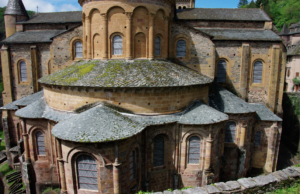Christian Heck is a former professor of art history at the University of Lille-III and today a senior member of the Institut Universitaire de France and holder of the chair of medieval iconography. In the course of his research, he has forged links with the École Biblique.
Following the death of the artist Pierre Soulages, with whom he had worked closely, the École Biblique wished to invite him to speak to us about his research on this painter who had shaken up the art world.
Christian, can you tell us a little more about your career ?
I have never regretted choosing to study art history and archaeology at university. Art history, which can best be defined as “learning to look”, has only nurtured the encounter, in the course of a lifetime, with human creations from all civilisations and periods. Furthermore, as a specialist in Western medieval art, I have been lucky enough to work both in the museum world, having spent ten years as chief curator of the Musée d’Unterlinden in Colmar (with, among other things, the exceptional Grünewald Issenheim Altarpiece), and in the academic world, having been a professor successively at the universities of Strasbourg and Lille, before ending up with a chair in medieval iconography as a Senior Member of the Institut Universitaire de France.
What is your connection with the École Biblique ?
A few days’ stay for an academic conference in Jerusalem a few years ago allowed me to get to know the EBAF, and the superb project of the BEST. I was soon able to propose to its directors that I contribute to the Art History section.
Moreover, for a work in medieval iconography, it is obvious that any work concerning the biblical text is an essential contribution.
The book I am publishing this autumn on the iconography of the Annunciation altarpiece in Aix-en-Provence (painted by Barthélémy d’Eyck in 1443-1444), is totally nourished by work through the biblical exegesis of the Fathers of the Church and theologians of the Middle Ages.
What does the painter Pierre Soulages mean to you ?
Forty years of a deeply intimate relationship, which began when I organised an exhibition of his paintings at the Colmar museum. From meetings to interviews, Soulages was deeply pleased with the texts I started to write about his painting, and he later proposed that I follow the work he carried out over several years to create the stained glass windows of Conques, inaugurated in 1994. It is not necessary to recall the place of his creations in the art of the 20th and early 21st centuries.
When the École Biblique proposed me to speak for a Thursday conferences, I proposed this theme, in resonance with a new research I have been carrying out on these stained-glass windows and the link with Soulages’ painting, since 2019, at the request of Pierre and Colette Soulages, a research which has taken the final form of a book which will be published at the end of October 2023.
The conference could not be recorded, in order to keep the exclusivity for the release of your book.
But then, can you tell us a few words about these stained glass windows and the great work done in Conques ?
In Conques, Soulages’ stained glass windows do not use light; they serve it. I would like to quote three words from Soulages about this creation.
“This is what impressed me so much in this adventure: to create for such a place a material that marks the passing of time is an encounter that has a deep meaning and that has counted a lot in the continuation of my work”.
Elsewhere: “You don’t realise to what extent everything I do is linked to the stained glass windows I made in Conques, that is to say to light”.
And finally: “the diffused light I wanted […] a light caught in the glass itself […] This ‘transmuted’ light has the emotional quality, the interiority I was looking for, a metaphysical quality in keeping with the sacred character of this architecture”.
Through his practice, in a quest to listen to “secret and essential” inner regions, Soulages brings out, from the black of the paintings, from the white of the mass of glass of the bays of Conques, a transfigured light, which invites us to enter the space that unfolds there, and to let ourselves be touched by the reality of the forms, to live an experience of the inner light.



